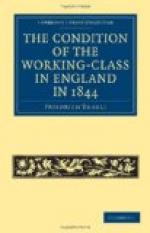“When we find the rate of mortality four times as high in some streets as in others, and twice as high in whole classes of streets as in other classes, and further find that it is all but invariably high in those streets which are in bad condition, and almost invariably low in those whose condition is good, we cannot resist the conclusion that multitudes of our fellow-creatures, hundreds of our immediate neighbours, are annually destroyed for want of the most evident precautions.”
The Report on the Sanitary Condition of the Working-Class contains information which attests the same fact. In Liverpool, in 1840, the average longevity of the upper-classes, gentry, professional men, etc., was thirty-five years; that of the business men and better-placed handicraftsmen, twenty-two years; and that of the operatives, day-labourers, and serviceable class in general, but fifteen years. The Parliamentary reports contain a mass of similar facts.
The death-rate is kept so high chiefly by the heavy mortality among young children in the working-class. The tender frame of a child is least able to withstand the unfavourable influences of an inferior lot in life; the neglect to which they are often subjected, when both parents work or one is dead, avenges itself promptly, and no one need wonder that in Manchester, according to the report last quoted, more than fifty-seven per cent. of the children of the working-class perish before the fifth year, while but twenty per cent. of the children of the higher classes, and not quite thirty-two per cent. of the children of all classes in the country die under five years of age. {108a} The article of the Artisan, already several times referred to, furnishes exacter information on this point, by comparing the city death-rate in single diseases of children with the country death-rate, thus demonstrating that, in general, epidemics in Manchester and Liverpool are three times more fatal than in country districts; that affections of the nervous system are quintupled, and stomach troubles trebled, while deaths from affections of the lungs in cities are to those in the country as 2.5 to 1. Fatal cases of smallpox, measles, scarlet fever, and whooping cough, among small children, are four times more frequent; those of water on the brain are trebled, and convulsions ten times more frequent. To quote another acknowledged authority, I append the following table. Out of 10,000 persons, there die—{108b}
Under 5-19 20-39
40-59 60-69 70-79 80-89 90-99 100 x
5 years
In Rutlandshire, a
healthy agricultural
district 2,865 891 1,275 1,299 1,189
1,428 938 112 3 Essex, marshy agricultural
district 3,159 1,110 1,526 1,413 963
1,019 630 177 3 Town of Carlisle, 1779-1787,
before
introduction of
mills 4,408 921 1,006 1,201 940
826 633 153 22 Town of Carlisle, after
introduction
of mills 4,738 930 l,201 1,134 677
727 452 80 1 Preston, factory town
4,947 1,136 1,379 1,114 553 532
298 38 3 Leeds, factory town 5,286
927 1,228 1,198 593 512 225 29
2




